We are not sure exactly what Esther’s maiden name was. It is different on almost every document. The variations we have seen are: Stern, Sterner, Sternson, Sterenson, Skay, Stein, Stain. We know that her sister, Rose, used the name Stein.
Assuming that Stern is her name, Stern is a German/Yiddish name meaning “star”.
On some of the children’s birth documents, we learn that Esther was from Odessa. In the Ukraine Database for Odessa, Stern is spelled Shtern.
At this point, we do not know anything about Esther’s parents other than their names were possibly Herman Sterner and Sarah Vinekur (as seen on Esther’s marriage license, but on her death certificate we see the name Rose for her mother. Since Rose was her sister’s name, I am thinking that Sarah might be the correct name.)
It appears that Esther arrived in the US in 1892. This is based on the 1900 census that says she was in the US for 8 years.
We don’t know how or where she met Morris, but they were married on May 3, 1893, in Milwaukee, WI.
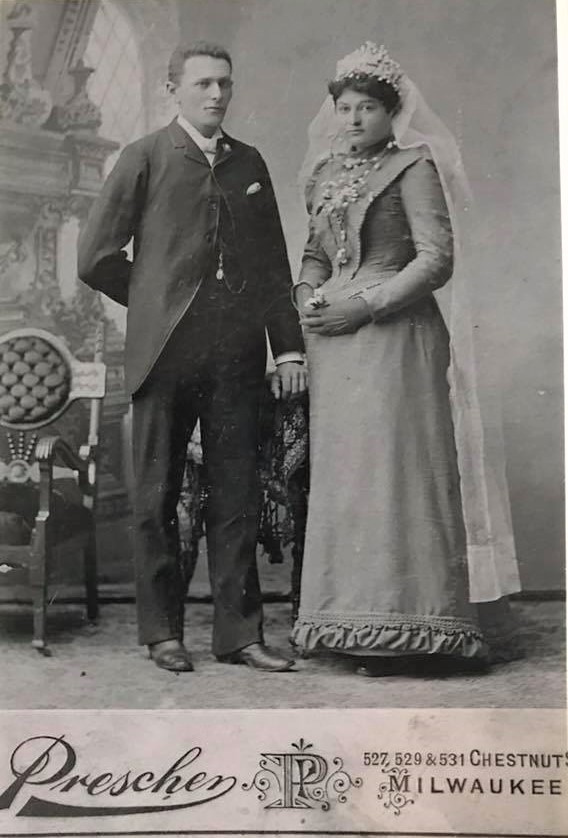
Their wedding photo was taken by photographer, Paul Prescher who was located at 527 Chestnut Street in Milwaukee, WI.
From posting the wedding picture on the Facebook Group Tracing the Tribe, we learned about Esther’s wedding dress:
- It was just a regular dress with some type of add-on bodice or necklace type accessory that was added just for the wedding day and the headpiece was made to match just for use on the wedding day so that later the dress could be worn without the accessory and the headpiece without the long train/vail. Back then many women were not able to afford a dress and headpiece just for the one day. Many got married in just their nicest dress and they were not necessarily white but whatever color their nicest dress was.
- The dress is common for that era and not specifically Russian or American. It is typical of globalized fashion. A lot of women married in a dark dress because just buying an expensive dress to wear for one single day was nothing most people could or wanted to afford. The wedding dress could then be used as “good” Shabbos or holiday dress. White was a luxury and a waste of resources. She has flowers or fake flowers pinned to the dress to make it more “weddingish”.
- Also, dye quality wasn’t what it is now, so you wanted to minimize the number of times you washed clothing, in order to prolong its life. Thus, in the long dress era, the bottom flounce was designed to be unsewn, washed, & resewn. If you were affluent enough, you might have an extra to mix & match. A story told to the commenter was about a friend’s grandmother who told her that in those days, you wore 7 petticoats. Every morning, you took the one you’d worn closest to you the day before & put it in the laundry. You took out a clean one & wore it as the outermost.
- The headpiece on the picture is the only distinctively Russian item. The rest is very standard and global.
- In the Jewish tradition, a headpiece was used as a symbol to show that the bride was a maiden.
According to government guidelines before 1920, if a husband got his naturalization papers, then his wife was automatically considered a citizen. Therefore, since Morris declared himself as naturalized, Esther did not have to apply for citizenship. In the 1905 census, she is listed as a citizen indicating that Morris was naturalized by then.
Morris and Esther’s first child, Benjamin, was born at home in Milwaukee on April 2, 1894. All of Esther’s children were born at home.
At some point before July 24, 1895, they family moved to Chicago, IL. Esther’s next two children were born there. Ida was born on July 24, 1895, and Rebecca (Becki) was born on August 5, 1896. Becki would later be known as Beattie.
Sometime after Beattie arrives, the family relocates to New York City and Anna was born there on Dec. 6, 1897, On her birth certificate, her given name was Sadie, but she was only known as Anna.
By 1897 then to Brooklyn, NY. Over the next 13 years, Esther has five more children in Brooklyn:
- Apr. 9, 1899 –Bertha, later known as Birdie
- Dec. 8, 1900 –Rose
- July 27, 1902 –Sam
- Aug. 9, 1907 –Peter
- Aug. 5, 1910 –Rudolph
In addition to having babies, Esther moved her household to a new apartment almost every year. Below is an example of how often they moved and where they lived.
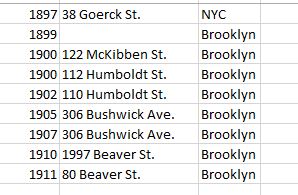
In 1904, Esther’s brother, Sam Sterensonz, arrived from Russia and in 1905 lived in the same boarding house that they did. We also know that Esther had a sister, Rose, who immigrated in 1907.
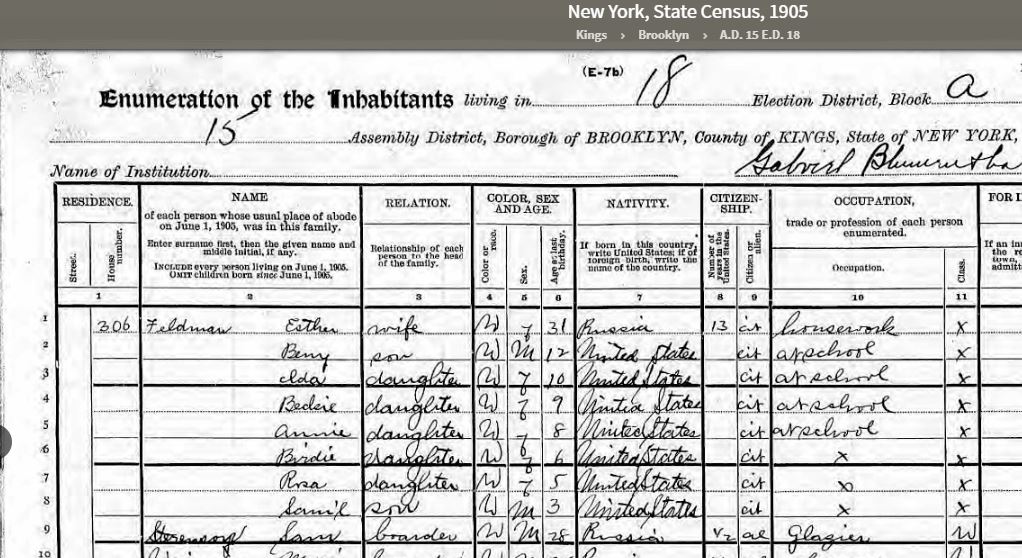
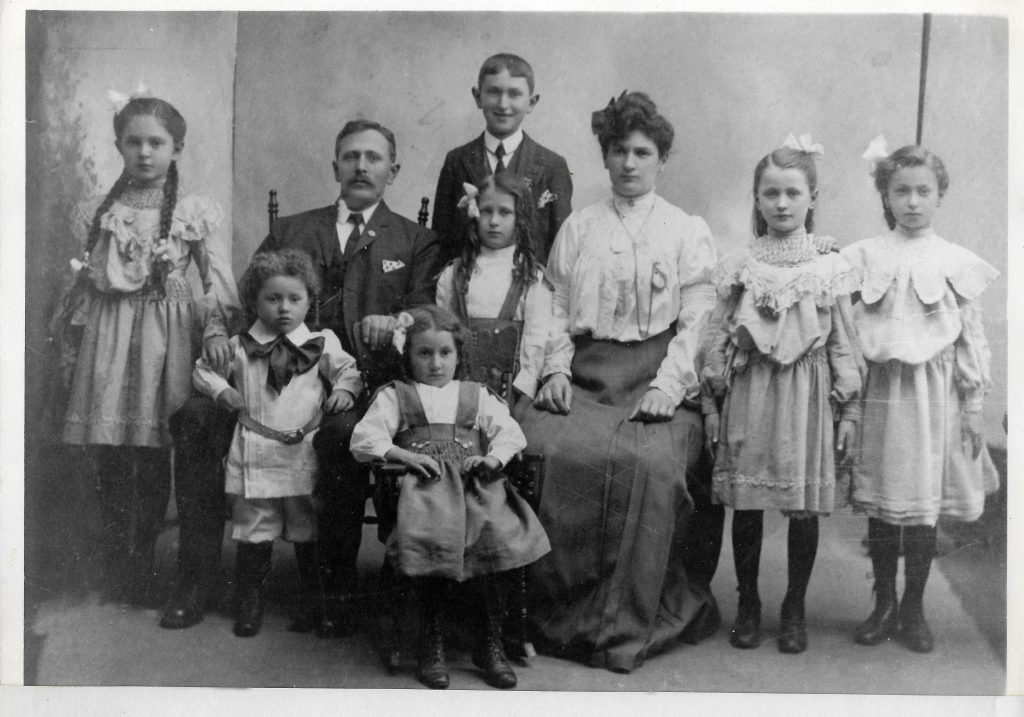
In early November of 1911, Esther was in the kitchen making challah with her daughters, when she suddenly felt ill. She started hemorrhaging and realized she needed help – and FAST. She told the children to run and get Papa. He was a cabinet maker and his shop was close to the house. The older children went running to the shop. “Come home, Papa” they screamed, “There is something wrong with Mama”.
He ran home to find his beloved Esther bleeding on the floor. She was rushed to the hospital but died a few days later. She left behind 9 children, ranging in age from 17 to 1, for Morris to raise on his own.
She would have be proud of him. He kept his family together, never putting them into foster care, and never separating them. He devoted the rest of his life to his family, and never remarried.
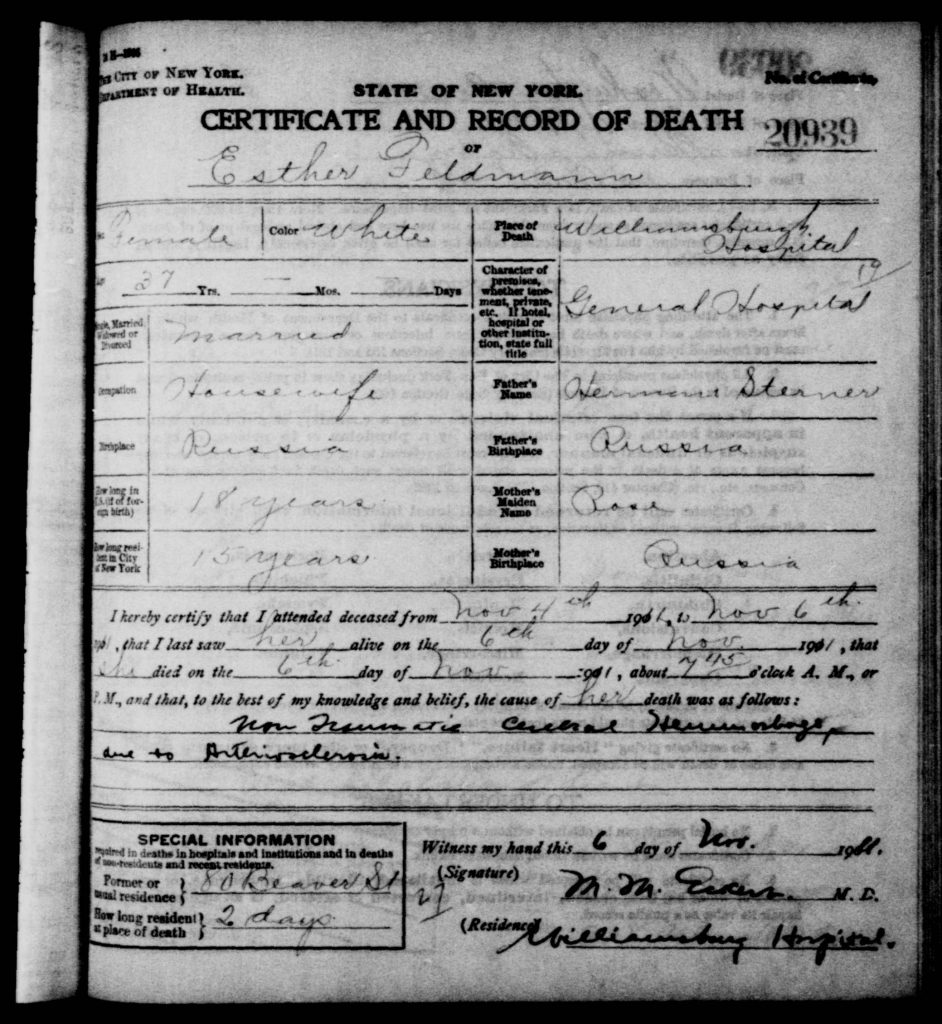
Esther came to the US as a young girl somewhere between 16 to 19 years of age. She married within a year of being here and worked hard to care for her family and make ends meet. She had 9 children in 16 years. She was only about 36 when she died.
Thanks to Morris’ love and support, her children went on to be successful adults that she would have been proud of.
As her children grew up and got married and had children of their own, each first child was named with a name that started with the letter “E” after Esther.
Esther is buried in the old Washington Cemetery #4 in Brooklyn, NY. R. Mandelblatt arranged for the burial. (R. Mandelblatt lived at 2216 E. 7th Ave. in Brooklyn. How did that person know the family?)
She is buried in the Bogopohler Kvuv Society Section in Cemetery 4 Post 348 Row 3 Grave #6. Bogopol was considered part of Odessa so it made sense for her to be buried in that section.
As of 2019, Esther has over 105 descendants from her 5 daughters.
- 9 Children
- 14 Grandchildren
- 27 Great-grandchildren
- 39 Great-great grandchildren
- And at least 25 great-great-great grandchildren and counting!
Notes:
Although her sons all married, they never had children of their own so there are no cousins with the last name of “Feldman” in Esther’s direct line.
Outstanding questions:
- Where were Esther’s parents from?
- How many siblings did she have?
- When did she come to the US and did she come alone?
- How did she meet Morris?
- How did she end up in Milwaukee?
- How did they move their possessions so frequently? How did they travel?
Sources:
- Paul Prescher Photographer https://www.langdonroad.com/po-to-py
- Tracing the Tribe, Facebook Group
